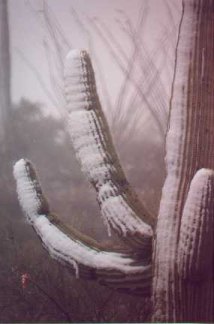|
 SAGUARO - Carnegiea gigantea (Cereus giganteus, Pilocereus g., engelmannii): Giant
Cactus, Pitahaya, Riesen Haar Kerzencactus, Sahuaro, Suaharo, Suwarro, Suwarrow, Zuwarrow. Akimel: Haa shan. Dine:
Xwoctitshahiih "awled cactus". Seri: Mojepe. Tohono: Hahshani. Ornamental. The name is pronounced "sah-wah-roh"
This is the tall cactus that appeared frequently on the sets of the television western High Chaparral. These cacti
grow between 1000 and 3000 ft. elevations, and are becoming more rare. This species is closely related to
Neobuxbaumea which grows in the mountains of southern Mexico. Saguaros die if a freeze lasts more than 36 hours. The
division between the Sonoran Desert and the Mojave Desert is a freeze line. The Saguaro is considered the indicator
of the Sonoran Desert. The plant is different from Cardón in that the branches come out of the plant more than 1/3 of
the way up the trunk, and there are fewer of them. The Saguaro has slimy flesh, while the Barrel Cactus has spongy
flesh.
SAGUARO - Carnegiea gigantea (Cereus giganteus, Pilocereus g., engelmannii): Giant
Cactus, Pitahaya, Riesen Haar Kerzencactus, Sahuaro, Suaharo, Suwarro, Suwarrow, Zuwarrow. Akimel: Haa shan. Dine:
Xwoctitshahiih "awled cactus". Seri: Mojepe. Tohono: Hahshani. Ornamental. The name is pronounced "sah-wah-roh"
This is the tall cactus that appeared frequently on the sets of the television western High Chaparral. These cacti
grow between 1000 and 3000 ft. elevations, and are becoming more rare. This species is closely related to
Neobuxbaumea which grows in the mountains of southern Mexico. Saguaros die if a freeze lasts more than 36 hours. The
division between the Sonoran Desert and the Mojave Desert is a freeze line. The Saguaro is considered the indicator
of the Sonoran Desert. The plant is different from Cardón in that the branches come out of the plant more than 1/3 of
the way up the trunk, and there are fewer of them. The Saguaro has slimy flesh, while the Barrel Cactus has spongy
flesh.
The flowers smell like ripe melon. The fruit is ripe in July just before or when its pod splits open to display a
crimson red center. A compound pole, made by fastening two or more ribs together end to end, with a hook on the upper
end, was used to harvest the fruit, which was a mainstay of the diet of several Indian nations. The fruit is
spineless. It is tasty fresh, dried, dried on the plant as a fruit leather, fermented and made into a drink called
Haashan navait in Akimel, or into wine, or it can be made into jelly or syrup. It is possible that the green fruit
frozen would be good, but I have not tried this. One could also suck the nectar with a straw. The tiny seeds, when
chewed thoroughly, are a good source of protein and fats. They can be ground into flour or a peanut butter-like
spread, or fed to chickens. They are rich in Vitamin C. The oil is a substitute for lard. The pulp of the plant is
edible raw or preserved. However, do not eat it; this is a protected species. The fruit is a reliable source of food
in late summer because it blooms every year, regardless of rainfall, because the plant stores sufficient water.

A gruel is made from the plant for stimulating milk production after childbirth. Such should be emergency uses
only. The wood is used to start fires with the bow and drill method, and the ribs are used for shelters, houses,
enclosures, roof joists, framework for wattle and daub houses, and corrals. The ribs are so impregnated with
mineral crystals that they dull tools quickly. They can also be used for splints for emergency medical care, or as
canes for the elderly, blind, and dancers. A piece of coal-heated stem (flesh) is wrapped in cloth and placed on
an aching part of the body in rheumatism. To seal an olla used to make wine, put leafy branches of Creosote around
the outside. Then burn dry saguaro flowers on the inside. The juice from the flowers seals the inside while the
Creosote seals the outside. The mashed seeds are also used in tanning, to soften deer skins. The boots formed in
the nest holes of woodpeckers are used to carry and store food and other small objects. The whitewing dove eats
the fruit and seeds. Grazing cattle trample out young plants. This cactus cannot be moved without a permit. Please
do not destroy this plant; it is becoming rare.

|

